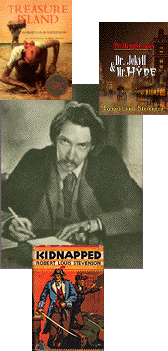November 13: Robert Louis Stevenson
Robert Louis Stevenson (1850)
It was on this date, November 13, 1850, that Scottish essayist, poet, and author of fiction and travel books, Robert Louis Stevenson was born in Edinburgh. He once quarreled with his father over religion and, thereafter, rarely mentioned his hostility to it. From childhood, Stevenson suffered from tuberculosis. He spend much time convalescing in bed, but spent it creating stories. He attempted to study engineering, but Stevenson's health redirected him to the law. Called to the bar in 1875, he gave that up to become a writer.
Stevenson's first notice came from his adventure story Treasure Island, which, as was the custom of the day, first appeared serialized in Young Folks magazine from 1881 to 1882. He followed this with the popular A Child's Garden of Verses in 1885, Kidnapped and The Strange Case of Dr. Jekyll and Mr. Hyde, both in 1886.
Stevenson relocated to Samoa, with his wife Fanny – his marriage to this divorcee was a bit of a scandal – and his widowed mother, a move that ultimately prolonged his life. There he wrote, up until the day he died, on December 3, 1894. His unfinished last work, Weir of Hermiston, was published posthumously (1896). Critics consider it his masterpiece.
On account of his pious mother, he held prayers at his house daily. But Stevenson's friend, Francis Watt, penned a 1913 biography of the famous novelist, in which he states that Stevenson "is properly described as an Agnostic."* Biographer Arthur Johnstone demonstrates that Stevenson was an Agnostic to the end of his life. He quotes Stevenson himself saying, "I am religious in my own way, but I am hardly brave enough to interpose a theory of my own between life and death. Here both our creeds and our philosophies seem to me to fail."**
* Francis Watt, R.L.S., 1913, p. 273.** Arthur Johnstone, Recollections of Robert Louis Stevenson in the Pacific, 1905.
Originally published November 2003 by Ronald Bruce Meyer.


